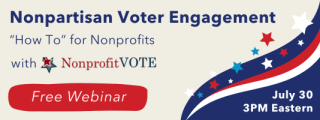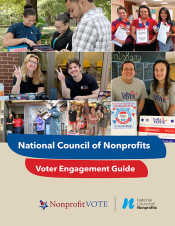Join the Free Webinar

As part of today’s release of the new Nonprofit Voter Engagement Guide, the National Council of Nonprofits and Nonprofit VOTE are delighted to present a free webinar: Nonpartisan Voter Engagement “How To” for Nonprofits. In this 45-minute webinar, attendees will get an in-depth look at how nonprofits can navigate election activities while remaining nonpartisan.
Join our national webinar on July 30, 2024 at 3:00pm Eastern to learn why and how nonprofits should do nonpartisan voter engagement between now and Election Day using the Nonprofit Voter Engagement Guide. Find out how easy it is to register eligible voters, share reliable information on polling places and voting, and engage with candidates in a nonpartisan way.
What Does the End of the “Chevron Doctrine” Mean to Charitable Nonprofits?
At the end of this year’s term, the Supreme Court rejected a 40-year rule that required judicial deference to the subject matter expertise of federal departments and agencies when interpreting statutory requirements through regulations. The ruling in Loper Bright Enters v. Raimondo could upend administrative law on federal regulations on everything from food and drug safety, clean air and water, health care, civil rights, worker rights and safety, education, transportation safety, and more. Specifically, the Court overturned its ruling in Chevron USA, Inc. v NRDC, which had required judges to defer to federal agencies’ interpretations of law. While it is unclear the extent to which Loper Bright will impact nonprofit organizations in the immediate future, the decision will likely result in more challenges to federal rulemaking which will in turn delay or alter reforms and relief for people charitable organizations serve. It is also expected that Treasury Department and Internal Revenue Service interpretations of the tax law will come under increased scrutiny by the courts as well.
Worth Quoting
- “It means chaos. This is the Supreme Court cutting back on agency power knowing that Congress can never pass a law that will answer all questions. But it limits what government can do to protect people, protect consumers and impose costs on big corporations.”
— Dorothy A. Brown, a law professor at Georgetown University, quoted in 8 policies that could be vulnerable to new legal challenges, Jacob Bogage, Washington Post, July 5, 2024.
- “The ruling will likely have seismic ramifications for health policy. A flood of litigation — with plaintiffs like small businesses, drugmakers, and hospitals challenging regulations they say aren’t specified in the law — could leave the country with a patchwork of disparate health regulations varying by location.”
— The Supreme Court Just Limited Federal Power. Health Care Is Feeling the Shockwaves, Stephanie Armour, KFF Health News, July 1, 2024.
Worth Reading
- The Supreme Court’s homelessness decision will decimate the faith-based nonprofit sector, Hannah Lebovits, Forward, July 2, 2024.
Federal FastView
- EEOC Announces Priorities: The newly released Strategic Enforcement Plan from the Equal Employment Opportunity Commission (EEOC) lays out several initiatives to “do more to combat employment discrimination, promote inclusive workplaces, and respond to the call for racial and economic justice” in Fiscal Years 2024-2028. The plan focuses on more categories of workers, such as LGBTQI+ individuals, persons with limited literacy or English proficiency, and workers facing mental health related disabilities, in its “vulnerable and underserved worker priority.” The priorities also seek to eliminate “barriers in recruitment and hiring” and “protecting vulnerable workers and persons from underserved communities from employment discrimination.”
- House Tax Committee Targets Nonprofit Colleges and Universities: Two bills that would impose various taxes and fines on higher educational institutions have passed out of the House Ways and Means Committee on party line votes. One bill, the “Protecting American Students Act” (H.R. 8913), would expand the number of colleges and universities subject to the current Endowment Tax imposed on colleges and universities enacted as part of the 2017 tax law. Another measure, the “University Accountability Act” (H.R. 8914), seeks to levy a financial penalty against schools that have a civil judgment against them for violating students' civil rights under Title VI of the Civil Rights Act. Although unlikely to become law this year, the bills lay out some of the tax-policy priorities of the Republican committee chair and many in his caucus in advance of the 2025 tax-reform debate.
- Review of Tax-Exempt “Churches”: The Internal Revenue Service should review several organizations, including a conservative think tank, that do not hold religious services to determine whether they qualify as churches under the Internal Revenue Code, according to a new letter by 40 Democratic Members of Congress. The letter urges the IRS to determine whether existing processes and guidance are sufficient to prevent abuse or improper political campaign activities. “We understand the importance of religious institutions to their congregants, and we believe that religious freedom is a cherished American value and constitutional right. We also believe that our tax code must be applied fairly and judiciously. Tax-exempt organizations should not be exploiting tax laws applicable to churches to avoid public accountability and IRS examination of their activities,” wrote the Representatives.
Election Tip
Published Today: The Nonprofit Voter Engagement Guide

Voting is not something we can take for granted. It’s time for nonprofits to get involved in voter registration, education, and engagement. To help do this, the National Council of Nonprofits and Nonprofit VOTE announce the Nonprofit Voter Engagement Guide to provide a roadmap and step-by-step guide for engaging at every stage of the process while remaining strictly nonpartisan.
Charitable nonprofit organizations have a critical role to play in promoting voting as a safe and accessible activity to strengthen our communities. The new Nonprofit Voter Engagement Guide lays out the rules of nonpartisanship, how to make a plan, tips for engaging potential voters, and permitted nonpartisan activities. Use it to effectively engage in elections on a nonpartisan basis, leverage your networks for greater impact, and build relationships with elected officials.
Don’t forget to also register for and join the July 30 webinar: Nonpartisan Voter Engagement “How To” for Nonprofits
American Rescue Plan Act Funds for Nonprofits
In less than six months, governments must ink written agreements to obligate their remaining State and Local Fiscal Recovery Funds (SLFRF) or send the money back to the federal government. Many local jurisdictions are getting the job done by making funds available to charitable nonprofits or sharing updates about their programs so that eligible organizations know of this once-in-a-generation opportunity.
- The Solano County, California, Board of Supervisors approved a Request for Qualifications so local nonprofits can submit proposals. The board will determine the amount at a later date.
- Last week, the Town of Trumbull, Connecticut, opened its ARPA Nonprofit Grant Program for applications. Successful applicants could receive grants of up to $20,000 for projects, programs, and services that “support the COVID-19 public health and economic response by addressing COVID-19 and its impact on public health as well as addressing economic harms to households, small businesses, nonprofits, impacted industries, and the public sector.” Nonprofits based in the town have until August 8 to apply.
- In June, the North Branford, Connecticut, Town Council held a ceremonial presentation to the nonprofits selected for the town’s Nonprofit Support Fund. North Branford had originally allocated $50,000 for the fund, but increased the total to $75,000 “after hearing all applications and evaluation of need.”
- In Missouri, the St. Louis Development Corporation recently announced that it had allocated more than $30 million to 295 nonprofits and small businesses in north St. Louis. About 170 entities each qualified for a $25,000 operational expansion grant to either maintain or expand capacity. Twenty-two others, including an Urban League chapter, qualified for community enhancement grants averaging nearly $1 million each for improvements and new construction.
- In Lancaster County, Pennsylvania, Commissioners presented Bench Mark, a local nonprofit, with $317,933 in funds that were approved in February. The award comes out of the County’s SLFRF allocation and is described as “bridge funding” given that other grants had run out and its next source of ongoing funding will take effect next year.
- After navigating Wisconsin state law requirements, Winnebago County has issued individual grants of $500,000 to local operations of Habitat for Humanity, Boys & Girls Clubs, and YMCAs, as well as grants to counseling and recovery nonprofits. The funds were reportedly delayed over questions of whether the SLFRF dollars could be granted on an up-front basis or had to be paid as reimbursements. The federal government actually treats up-front payments as the default method.
Charitable nonprofits are encouraged to contact their local government officials on the status of these funds and confirm whether the funds have been obligated. Learn more on how to access SLFRF funds by reading: State and Local Fiscal Recovery Funds Still Available for the Asking. So Ask!.
A SLFRF Did You Know?
Fewer than six months remain for your nonprofit to access State and Local Fiscal Recovery Funds. Here are three things you can do to make sure you don’t miss out on this once-in-a-lifetime opportunity:
- Contact your local and county offices – like your City Manager and County Budget Office – to inquire about the status of these funds and for a link that shows whether funds are still available (most likely there are).
- Develop a written or verbal proposal for your nonprofit. You can customize our template letter of inquiry to send to offices or testify at a meeting.
- Share this message with your nonprofit networks. The more decisionmakers hear from nonprofits, the more likely they are to partner with them. Advocacy makes a difference – it’s how charitable nonprofits secured eligibility for these funds in the first place.
See more at Accessing State and Local Fiscal Recovery Funds.
New State Tax Laws in Effect July 1
The beginning of this month triggered the effective dates for new tax laws in more than a dozen states.
- Income Tax: Taxpayers in Colorado, Georgia, Kansas, North Carolina, and Utah will see lower income tax rates; the Georgia and Kansas laws applying retroactively. Colorado taxpayers may also benefit from a revised state earned income tax rate, increased from 38% to 50% of the federal credit. Individual taxpayers in Kansas and West Virginia will also be able to take advantage of additional exemptions.
- Property Tax: A 2005 law that limited municipal property taxes in Maine has been repealed, which may result in increased local property taxes in the near future.
- Sales Tax: Due to Colorado’s unique Taxpayer Bill of Rights (TABOR) law and a $1.5 billion projected surplus, the statewide sales tax rate will be reduced by .13%. Lawmakers in Indiana, North Carolina, and Wyoming have removed transaction thresholds for economic nexus purposes, meaning any seller with sales of $100,000 or more in those states, regardless of the number of transactions, will now be required to collect and remit sales tax to the state. Interstate sales in Tennessee will now be taxed based on destination sourcing, which is more consistent with the interstate Streamlined Sales Tax and Use Agreement used by most states. A recent Nevada regulatory amendment clarifies that an exemption letter from sales and use tax for eligible charitable nonprofits applies only to tax liabilities from the date of the letter onward.
- Tax Filings: A new law in North Carolina provides for automatic extension of state income tax returns when the Internal Revenue Service grants an extension of the corresponding federal return. For nonprofits that have unrelated business income and file Form 990-T with the IRS, this change means that any extension of their 990-T filing deadline now automatically applies to their state corporate income tax filing as well.
Worth Quoting
On funding for nonprofits
- “This budget agreement - the largest in New York City history - reinforces #WHY15’s key point: an arbitrary, across-the-board 15% budget reduction with no transparency about decision-making and no consultation with the nonprofits doing the work that keeps our city going, is not the way to serve New Yorkers.”
— Nonprofit New York #WHY15 Statement on the Fiscal Year 2025 Adopted Budget, Nonprofit New York, July 8, 2024, commenting on the successful advocacy campaign to reverse spending cuts and negotiate reasonable reimbursement rates for nonprofit serve providers in New York City.
On nonprofits and trust
- “We face major issues in our society and in communities. Public charities are at the center of finding solutions by working in ways that center innovation, belonging, humanity, and compassion. Our work is neighbors helping neighbors with integrity and care. Casting it otherwise undermines the remaining civic trust we have with one another and diminishes our ability to collectively rise to meet the challenges before us.”
— Adam Jespersen, Executive Director of the Montana Nonprofit Association, quoted in Local Public Charities are Not ‘Dark Money’ Groups, Flathead Beacon, June 22, 2024.
Numbers in the News
$86 billion
The amount of State and Local Fiscal Recovery Funds still available at state, local, Tribal, and territorial governments, as of March 31, 2024. An estimated $264 billion has been spent or obligated since May 2021.
Source: Public Data on State and Local Fiscal Recovery Funds, U.S. Department of the Treasury, July 2024.
$2.9 billion
The economic impact of nonprofits in the Greater Cincinnati area, according to a study by the Alpaugh Family Economics Center at the University of Cincinnati. In addition, Greater Cincinnati nonprofits supported 41,023 jobs and generated $87.1 million in earnings and sales tax revenue.
Source: 2024 Nonprofit Economic Impact Report, One Source, July 11, 2024.
Nonprofit Events
- July 18, Advocacy Hour, Nonprofit Association of Washington
- July 23, Advocacy 101 (series), Florida Nonprofit Alliance
- Aug. 13, Summer Joint Policy Forum, New Jersey Center for Nonprofits
- Aug. 22, Making Advocacy Actionable, Maine Association of Nonprofits
- Aug. 14-15, Nonprofit Advocacy: How to Tell Your Story Using Values-Based Narratives, Minnesota Council of Nonprofits
- Aug. 27-28, Idaho Nonprofit Conference, Idaho Nonprofit Center

Lessons Learned from a Career Advancing Charitable Nonprofits
The Advocacy in Action section of this newsletter is dedicated to highlighting inspiring stories of individuals and groups that talk the talk and walk the walk, running innovative advocacy campaigns, collecting and wielding data, and championing the public good in multiple ways. Tim Delaney, President & CEO of the National Council of Nonprofits for the past 16 years, exemplifies all of these ideals and more. In recognition of his retirement today, NCN staff asked Tim to share some of the lessons he has learned from building the largest network of nonprofits in North America and leading effective advocacy at the local, state, and federal levels and in all three branches of government.
Stay in the Loop
Want to be the first to know policy developments and operational trends affecting nonprofits? Sign-up to receive our free newsletters, Nonprofit Champion and Nonprofit Essentials, and browse the archive of past editions.
Sign-up